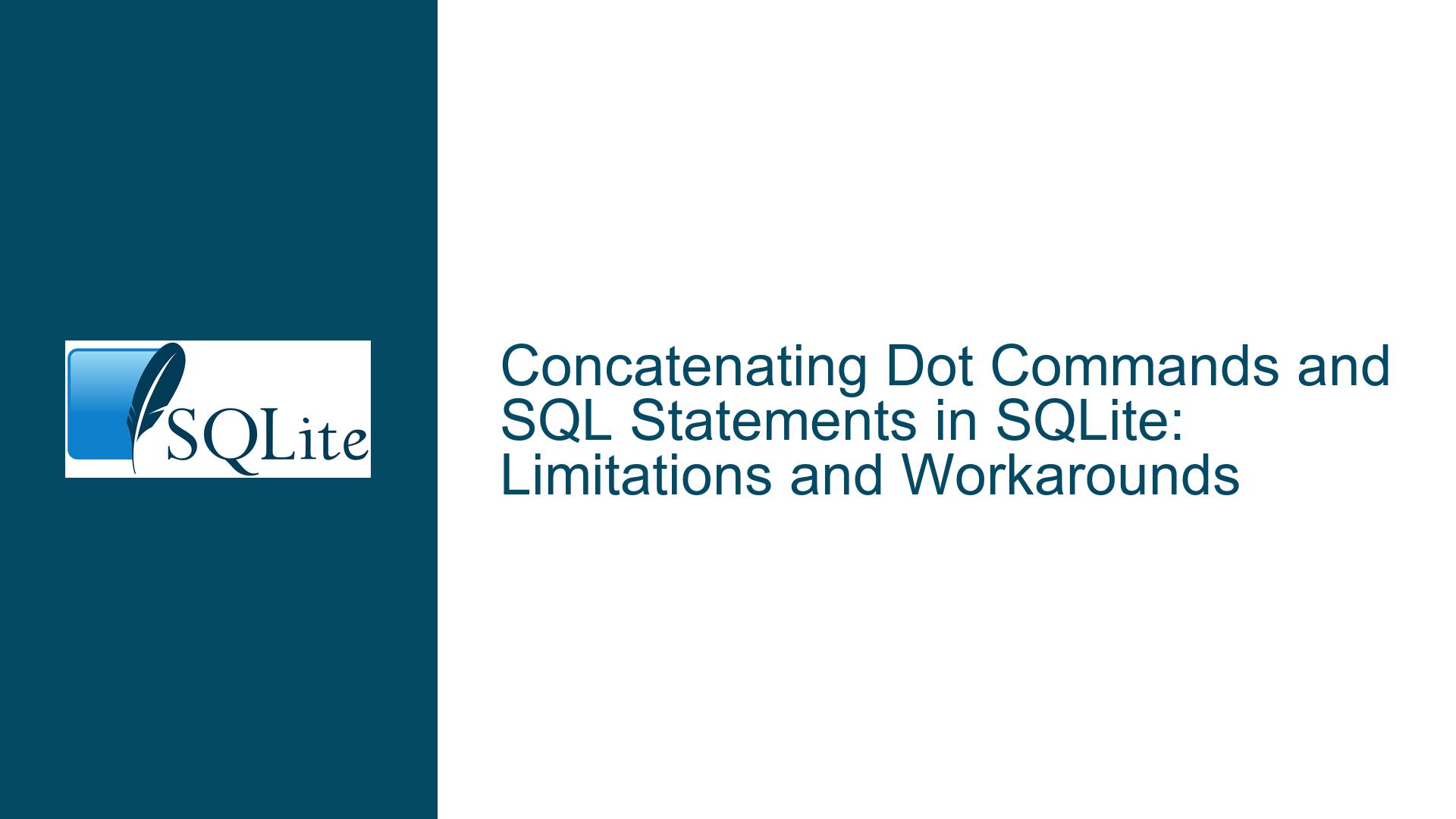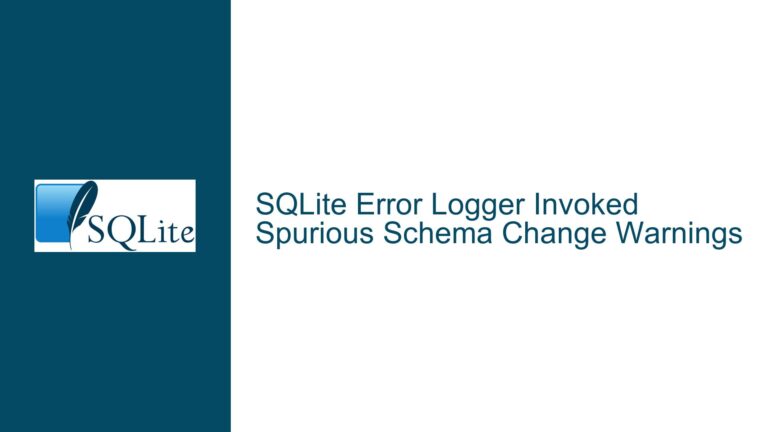Concatenating Dot Commands and SQL Statements in SQLite: Limitations and Workarounds
Issue Overview: Concatenating Dot Commands and SQL Statements in SQLite
SQLite is a lightweight, serverless database engine that is widely used for its simplicity and efficiency. One of the key features of SQLite is its command-line interface (CLI), which allows users to interact with the database using both SQL statements and dot commands. Dot commands are special commands that are specific to the SQLite CLI and are used to control the behavior of the CLI itself, such as setting output modes, opening databases, or configuring display options. SQL statements, on the other hand, are used to interact with the database, such as querying or modifying data.
A common question that arises when working with the SQLite CLI is whether it is possible to concatenate multiple dot commands or SQL statements into a single line or command. Concatenation, in this context, refers to the ability to combine multiple commands or statements into a single input, which can then be executed sequentially by the SQLite CLI. This is particularly useful in scenarios where users want to automate tasks, such as running a series of commands or statements in a single batch, or when integrating SQLite with other tools or scripts that require input redirection.
The discussion in the forum highlights two main questions:
- Is it possible to concatenate multiple dot commands in SQLite?
- Is it possible to concatenate SQL statements with dot commands?
The short answer to both questions is that concatenation of dot commands is not supported in SQLite, while concatenation of SQL statements is possible but comes with certain caveats. The inability to concatenate dot commands can be a significant limitation, especially for users who are trying to automate tasks or integrate SQLite with other tools. However, there are workarounds and alternative approaches that can be used to achieve similar results.
Possible Causes: Why Concatenation of Dot Commands is Not Supported
The inability to concatenate dot commands in SQLite stems from the way the SQLite CLI processes input. Dot commands are treated differently from SQL statements by the CLI. When the CLI encounters a dot command, it interprets it as a command to be executed immediately, rather than as part of a larger sequence of commands. This is because dot commands are specific to the CLI and are not part of the SQL language. As a result, the CLI does not provide a mechanism for concatenating multiple dot commands into a single input.
One of the key reasons for this limitation is the design of the SQLite CLI itself. The CLI is designed to be a simple, interactive tool that allows users to execute commands and statements one at a time. While this design makes the CLI easy to use, it also limits its flexibility when it comes to more complex tasks, such as running multiple commands or statements in a single batch. Additionally, the CLI does not provide a way to chain or combine dot commands, as each dot command is treated as a separate, independent command.
Another factor that contributes to this limitation is the way dot commands are parsed and executed by the CLI. Dot commands are parsed by the CLI’s input processor, which expects each dot command to be on a separate line. This means that if multiple dot commands are concatenated into a single line, the CLI will not be able to parse them correctly, resulting in an error. For example, if you try to concatenate the commands .mode column and .open './db/chinook.db' into a single line, the CLI will interpret the second command as an extra argument to the first command, resulting in an error message such as "extra argument: ‘./db/chinook.db’".
In contrast, SQL statements can be concatenated because they are processed by the SQLite library, rather than by the CLI itself. The SQLite library allows multiple SQL statements to be executed sequentially, as long as they are separated by semicolons. However, this does not apply to dot commands, as they are not part of the SQL language and are not processed by the SQLite library.
Troubleshooting Steps, Solutions & Fixes: Workarounds for Concatenating Dot Commands and SQL Statements
While concatenation of dot commands is not supported in SQLite, there are several workarounds and alternative approaches that can be used to achieve similar results. These workarounds involve using different techniques to execute multiple dot commands and SQL statements in a single batch, without the need for concatenation.
1. Using Line Breaks to Separate Dot Commands
One of the simplest workarounds is to use line breaks to separate dot commands, rather than trying to concatenate them into a single line. This approach involves writing each dot command on a separate line, followed by the SQL statements that need to be executed. For example, instead of trying to concatenate the commands .mode column and .open './db/chinook.db', you can write them on separate lines, like this:
.mode column
.open './db/chinook.db'
select * from employees;
This approach works because the SQLite CLI processes each line of input separately. When the CLI encounters a dot command, it executes it immediately, and then moves on to the next line. This allows you to run multiple dot commands and SQL statements in a single batch, without the need for concatenation.
This approach is particularly useful when working with input redirection, where the input is provided via standard input (stdIn). In this case, you can write the commands to stdIn with line breaks separating each command, and the CLI will process them sequentially. For example, if you are using a script to generate the input, you can write the commands to stdIn like this:
write(stdout, ".mode column\n.open './db/chinook.db'\nselect * from employees;")
In this example, the \n character is used to represent a line break, which separates each command. When the CLI processes this input, it will execute each command in sequence, starting with .mode column, followed by .open './db/chinook.db', and finally the SQL statement select * from employees;.
2. Using the .read Command to Execute Commands from a File
Another workaround is to use the .read command to execute a series of dot commands and SQL statements from a file. This approach involves creating a text file that contains the dot commands and SQL statements that you want to execute, and then using the .read command to execute the contents of the file.
For example, you can create a file called init.sql that contains the following commands:
.mode column
.open './db/chinook.db'
select * from employees;
Once the file is created, you can execute the commands in the file using the .read command, like this:
.read init.sql
This approach has several advantages. First, it allows you to organize your commands and statements in a single file, which can be easily edited and reused. Second, it allows you to execute a large number of commands and statements in a single batch, without the need for concatenation. Finally, it provides a way to automate tasks, as you can use scripts or other tools to generate the file and then execute it using the .read command.
3. Using the -init Flag to Load Commands from a File at Startup
Another approach is to use the -init flag to load commands from a file when the SQLite CLI starts up. This approach is similar to using the .read command, but it allows you to specify the file that contains the commands as part of the command-line arguments when starting the CLI.
For example, if you have a file called init.sql that contains the following commands:
.mode column
.open './db/chinook.db'
select * from employees;
You can start the SQLite CLI with the -init flag, like this:
sqlite3 -init init.sql
When the CLI starts, it will automatically load and execute the commands in the init.sql file. This approach is particularly useful when you want to automate the execution of a series of commands every time you start the CLI.
4. Using the .sqliterc File for Persistent Configuration
If you have a set of dot commands that you want to execute every time you start the SQLite CLI, you can use the .sqliterc file to store these commands. The .sqliterc file is a configuration file that is automatically loaded by the SQLite CLI when it starts up. This file is typically located in your home directory, and it can contain any dot commands that you want to execute automatically.
For example, if you want to set the output mode to column and enable headers every time you start the CLI, you can create a .sqliterc file with the following contents:
.mode column
.headers on
Once the file is created, the CLI will automatically execute these commands every time it starts up. This approach is particularly useful for setting up a consistent environment for working with SQLite, as it allows you to configure the CLI to your preferences without having to manually enter the commands each time.
5. Using Command-Line Arguments for Common Options
Finally, some common options can be specified directly on the command line when starting the SQLite CLI. For example, if you want to set the output mode to column, you can use the -column flag when starting the CLI, like this:
sqlite3 -column
This approach is useful for quickly setting common options without the need for dot commands or configuration files. However, it is limited to a small set of options, and it does not provide the same level of flexibility as the other approaches discussed above.
Conclusion
While concatenation of dot commands is not supported in SQLite, there are several workarounds and alternative approaches that can be used to achieve similar results. These include using line breaks to separate dot commands, using the .read command to execute commands from a file, using the -init flag to load commands from a file at startup, using the .sqliterc file for persistent configuration, and using command-line arguments for common options. By using these techniques, you can automate tasks, integrate SQLite with other tools, and configure the CLI to your preferences, without the need for concatenation.






